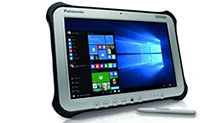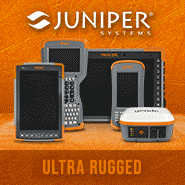December 2018
Speed Demon Top 10: Rugged Tablets By and large, performance matters in computers as much as it does in vehicles and a lot of other machinery and items we use in our daily lives. Performance, of course, isn't everything. Unless you're a race car driver and need so and so much performance to be competitive, the extra cost of the highest possible performance is a luxury rather than a necessity. What it boils down to is getting as much performance as is needed. That said, we love performance and so we're listing the "speed demons" among the rugged tablets we've tested over the past several years. Gold, Silver and Bronze galore. [See 2018 Speed Demon Top 10: Rugged Tablets] -- Posted Thursday, December 27, 2018
By and large, performance matters in computers as much as it does in vehicles and a lot of other machinery and items we use in our daily lives. Performance, of course, isn't everything. Unless you're a race car driver and need so and so much performance to be competitive, the extra cost of the highest possible performance is a luxury rather than a necessity. What it boils down to is getting as much performance as is needed. That said, we love performance and so we're listing the "speed demons" among the rugged tablets we've tested over the past several years. Gold, Silver and Bronze galore. [See 2018 Speed Demon Top 10: Rugged Tablets] -- Posted Thursday, December 27, 2018
MobileDemand: Rugged tablets in the cold
 MobileDemand points out in its always informative blog that with winter upon us, ice and snow won’t be the only thing that may pose a problem. If you work out in the field, consumer grade technology won’t last long in the frigid environment. They’re designed for use in stable, indoor climates. So how do you prepare for the winter months ahead? With specialized technology. Most consumer grade tablets have a limited operating temperature between 32°F (0°C) and 95°F (35°C). While this may seem like an impressive range, very few environments maintain these temperatures year-round without some form of climate control. Depending how far north you travel, temperatures can fall as low as -45°F (-42.78°C) or lower. [See Rugged tablets in the cold] -- Posted Thursday, December 27, 2018
MobileDemand points out in its always informative blog that with winter upon us, ice and snow won’t be the only thing that may pose a problem. If you work out in the field, consumer grade technology won’t last long in the frigid environment. They’re designed for use in stable, indoor climates. So how do you prepare for the winter months ahead? With specialized technology. Most consumer grade tablets have a limited operating temperature between 32°F (0°C) and 95°F (35°C). While this may seem like an impressive range, very few environments maintain these temperatures year-round without some form of climate control. Depending how far north you travel, temperatures can fall as low as -45°F (-42.78°C) or lower. [See Rugged tablets in the cold] -- Posted Thursday, December 27, 2018
VDC: Watch out, Windows: Android is making serious waves in the enterprise tablet market
In its latest report, VDC Research says that, already the dominant force in the consumer-grade mobile OS arena, Android is now steadily encroaching on Windows’ turf as a viable OS for fully rugged tablet solutions. Security concerns have been mollified by robust improvements. EMM vendors have built support capabilities for Android deployments, no longer forcing enterprises into a Windows box. And with lower cost tablets to boot, Android is giving Windows a run for its money.VDC's latest report, The Global Market for Enterprise Tablets, examines the opportunity for rugged and non-rugged slate tablets and 2-in-1 detachable devices supporting enterprise workflows. Key trends around OS, display size, cellular connectivity, form factor, target market and application are covered. [See VDC Executive Brief] -- Posted Friday, December 21, 2018
Juniper Systems: How to a Windows Mobile handheld to a PC
 Juniper System pointed out that Microsoft support for the Windows Mobile operating system ended in 2010, and each Windows 10 update made USB file transfers using Windows Mobile Device Center more improbable. Since there still are a large number of Windows Mobile-based devices out there, Juniper Systems launched Mobile Connect to support its Windows Mobile users for years to come. [See "How to use Mobile Connect on a Windows Mobile handheld"] -- Posted Friday, December 21, 2018
Juniper System pointed out that Microsoft support for the Windows Mobile operating system ended in 2010, and each Windows 10 update made USB file transfers using Windows Mobile Device Center more improbable. Since there still are a large number of Windows Mobile-based devices out there, Juniper Systems launched Mobile Connect to support its Windows Mobile users for years to come. [See "How to use Mobile Connect on a Windows Mobile handheld"] -- Posted Friday, December 21, 2018
Centrica equips its engineers with 7500 Panasonic rugged tablets
 Centrica, a leading energy and services company operating brands such as British Gas and Dyno, has rolled out 7,500 Panasonic FZ-G1 rugged tablets to its team of UK engineers to improve working methods and ultimately to enhance its customer service. For the past eight years the company's engineers have been using the Panasonic Toughbook CF-19 rugged notebooks as their main technology tool for job scheduling, maintenance, viewing diagrams and communications as they carry out service and repairs at customers' homes and businesses. However, the company wanted to move to a tablet-based device for more intuitive applications for working methods, more flexibility and because its engineers were already very familiar with this type of technology. [See Panasonic media release] -- Posted Thursday, December 13, 2018
Centrica, a leading energy and services company operating brands such as British Gas and Dyno, has rolled out 7,500 Panasonic FZ-G1 rugged tablets to its team of UK engineers to improve working methods and ultimately to enhance its customer service. For the past eight years the company's engineers have been using the Panasonic Toughbook CF-19 rugged notebooks as their main technology tool for job scheduling, maintenance, viewing diagrams and communications as they carry out service and repairs at customers' homes and businesses. However, the company wanted to move to a tablet-based device for more intuitive applications for working methods, more flexibility and because its engineers were already very familiar with this type of technology. [See Panasonic media release] -- Posted Thursday, December 13, 2018
Juniper Systems: Mobile device manufacturers should stop building batteries for front-end battery performance
 In its latest blog entry, Juniper Systems observes that lots of mobile device manufacturers tout big batteries. They put more powerful batteries into their devices and claim longer battery life. However, they are not talking about an equally important battery measure – one that more manufacturers should design around and eventually brag about – battery cycle life. As is, many consumer products only provide a year and a half of healthy battery performance. By comparison, Juniper points out, their systems are designed to optimize battery life. [See Mobile device manufacturers should stop building batteries for front-end battery performance] -- Posted Thursday, December 13, 2018
In its latest blog entry, Juniper Systems observes that lots of mobile device manufacturers tout big batteries. They put more powerful batteries into their devices and claim longer battery life. However, they are not talking about an equally important battery measure – one that more manufacturers should design around and eventually brag about – battery cycle life. As is, many consumer products only provide a year and a half of healthy battery performance. By comparison, Juniper points out, their systems are designed to optimize battery life. [See Mobile device manufacturers should stop building batteries for front-end battery performance] -- Posted Thursday, December 13, 2018
Zebra survey finds two-thirds of retail store associates believe they can provide better customer service with tablets
Zebra Technologies Corporation (NASDAQ: ZBRA), an innovator at the edge of the enterprise with solutions and partners that enable businesses to gain a performance edge, today revealed the results of its 11th annual Global Shopper Study, analyzing the attitudes, opinions, and expectations of shoppers, retail associates, and retail decision makers. The results show that two-thirds (66 percent) of surveyed associates believe that if they are equipped with tablets, they could provide better customer service and improve the shopping experience. [See Zebra media release] -- Posted Tuesday, December 11, 2018
Panasonic: Technology buyers favor spreading the cost of mobile workforce computing
According to a study by Panasonic (Mobile Computing as a Service), technology buyers are in favor of spreading the cost of equipping their mobile workforces with notebooks, tablets and handheld devices, the latest research reveals. 78% of UK technology buyers said they would be interested in a subscription-based solution to equip mobile workforces. Currently buyers say their top considerations when purchasing mobile devices for their workforce are cost (72%) and life expectancy of the product (54%). Yet the majority of buyers still expect to replace their mobile workforces' devices every 2-3 years. Buyers said an "As a Service" approach for mobile hardware, as opposed to paying out in advance with a large, one-off capital expenditure, would help them to purchase up to date technology more quickly (54%), manage costs better (49%) and free up budget to purchase more accessories (34%). [See Panasonic media release] -- Posted Wednesday, December 5, 2018
Wearables see double-digit growth Q3 year-on-year
According to IDC, global shipments of wearable devices reached 32.0 million units in the third quarter of 2018 (3Q18), up 21.7% from the previous year. "Many of the new basic wearables include features like notifications or simple app integrations that bleed into smartwatch territory," said Jitesh Ubrani senior research analyst for IDC Mobile Device Trackers.. Our take: While wearables, for now, are mostly smartwatches and fitness/health trackers, growing acceptance of wrist-worn electronics will undoubtedly spawn uses in enterprise and vertical markets, including rugged applications. [See IDC media release] -- Posted Monday, December 3, 2018
What happend in rugged computing 10 years ago: December 2008
In December 2008, we reported that Trimble had added the powerful Juno SB and SC handhelds with integrated GPS, Two Technologies had introduced the Safari handheld, Sonim partnered with Land Rover to make rugged phones, and DRS had received a $531 million Army contract extension for rugged systems. We reviewed the Handheld M3 Mobile, took a GD-Itronix MR1 rugged UMPC on a maritime dive expedition in Honduras, ran case studies on rugged mobile printers in mining operations and the use of rugged digital video systems on police motorcycles, announced that Toshiba was first in offering 512GB SSDs, and discussed the importance of being able to lock USB ports on compromised computers. [See what happened in rugged computing five years ago in October 2008] -- Posted Monday, December 3, 2018





















 By and large, performance matters in computers as much as it does in vehicles and a lot of other machinery and items we use in our daily lives. Performance, of course, isn't everything. Unless you're a race car driver and need so and so much performance to be competitive, the extra cost of the highest possible performance is a luxury rather than a necessity. What it boils down to is getting as much performance as is needed. That said, we love performance and so we're listing the "speed demons" among the rugged tablets we've tested over the past several years. Gold, Silver and Bronze galore. [See
By and large, performance matters in computers as much as it does in vehicles and a lot of other machinery and items we use in our daily lives. Performance, of course, isn't everything. Unless you're a race car driver and need so and so much performance to be competitive, the extra cost of the highest possible performance is a luxury rather than a necessity. What it boils down to is getting as much performance as is needed. That said, we love performance and so we're listing the "speed demons" among the rugged tablets we've tested over the past several years. Gold, Silver and Bronze galore. [See 

 Centrica, a leading energy and services company operating brands such as British Gas and Dyno, has rolled out 7,500 Panasonic FZ-G1 rugged tablets to its team of UK engineers to improve working methods and ultimately to enhance its customer service. For the past eight years the company's engineers have been using the Panasonic Toughbook CF-19 rugged notebooks as their main technology tool for job scheduling, maintenance, viewing diagrams and communications as they carry out service and repairs at customers' homes and businesses. However, the company wanted to move to a tablet-based device for more intuitive applications for working methods, more flexibility and because its engineers were already very familiar with this type of technology. [
Centrica, a leading energy and services company operating brands such as British Gas and Dyno, has rolled out 7,500 Panasonic FZ-G1 rugged tablets to its team of UK engineers to improve working methods and ultimately to enhance its customer service. For the past eight years the company's engineers have been using the Panasonic Toughbook CF-19 rugged notebooks as their main technology tool for job scheduling, maintenance, viewing diagrams and communications as they carry out service and repairs at customers' homes and businesses. However, the company wanted to move to a tablet-based device for more intuitive applications for working methods, more flexibility and because its engineers were already very familiar with this type of technology. [ In its latest blog entry,
In its latest blog entry, 

 "Over the many years that we have been testing and reviewing rugged mobile computers, and in our professional careers prior, we have noticed that there is very little standardization and that potential clients are often confused where and what to buy," said Dr. Conrad H. Blickenstorfer, Editor-in-Chief of RuggedPCReview.com and former CIO of the New York State Dormitory Authority. "We hope that our new service will answer many questions and provide all the answers a client needs to make an informed decision."
"Over the many years that we have been testing and reviewing rugged mobile computers, and in our professional careers prior, we have noticed that there is very little standardization and that potential clients are often confused where and what to buy," said Dr. Conrad H. Blickenstorfer, Editor-in-Chief of RuggedPCReview.com and former CIO of the New York State Dormitory Authority. "We hope that our new service will answer many questions and provide all the answers a client needs to make an informed decision."